S C O T L A N D : D A Y 5
AUGUST 23 (Wednesday) -- Oban
The next morning we were to tour the nearby coastal islands of Mull and Iona. The previously referred-to common-law wife having told us the day before that trying to drive ourselves around Mull was a very bad idea because the roads were so narrow, we elected to take one of the local coach tours. There were three available from the operator we selected: one which included shopping in Tobermory (yawn), one which included a tour of Duart Castle, centuries-old home of the Macleans of Duart (this was the tour I wanted), and one which just went to Iona and back (this was the only tour that wasn't already booked solid).
After spending some time making Beth and Ann annoyed with me for hurrying them (I didn't want to miss the ferry to Mull, and Beth for some obscure reason was slow getting ready that morning), we found ourselves glad we hadn't tried to drive ourselves across Mull. Many of the roads there are winding, single-track lanes, and the touring coaches virtually own them--we would have had a tough time driving safely.
Clem, the driver of the coach in which we wound up, was not only possessed of a rare dry wit, but he took the narrow roads as though all other vehicles were insignificant distractions. As he instructed us to smile and wave at the rather grumpy-looking driver of a competing tour line ("Ah, they hate it when I do this," he noted with a crocodilian grin), Clem also took the opportunity to unburden himself of various trenchant commentaries concerning the ownership of parts of the island of Mull.
"You see that bit there? The rock group Genesis own that bit, and I don't think much of them as they are long-distance landlords with no connection to the land. I believe that they and all others like them should be stripped of their property, and that the land should be given to the government to hold for the people."
I didn't want to be put off the coach, so I held my tongue concerning these socialist musings and concentrated on the scenery, which was astonishing. (The scenery, that is, not me holding my tongue.) One of the ways in which Scotland differs from America is that much of the Highlands and western coastland is utterly empty of trees. There is a low, emerald green grass covering the rolling, rocky hills, but virtually no trees except where stands are being raised for lumber. It is a strange, green desolation, only broken here and there by outcrops of weathered gray stone, small blue lochs, and the placid white sheep that graze everywhere.
As we approached the passenger ferry to Iona at Fionnphort, the gray rocks gave way to a pink granite which we were told was the likely source for much of the pink granite seen throughout the world. The rosy stone, covered here and there by green grass and bounded by blue sea, was a color combination I'd never seen before; it felt almost surreal, as if I had been made part of a postcard in which the pastel colors had been chosen at random. The heat wave had finally broken, leaving us shivering in the fine drizzle that we soon learned was common in the morning on the western coast. It seemed appropriate somehow; we spoke quietly, as though the holy nature of the tiny island across the water encouraged a sense of circumspect reverence.
After a short ferry ride we arrived in a tidy little village on Iona and began our walk to see the abbey and ruined monastery whose construction dates from the 13th century. This island holds a special place in the hearts of Scotland's Christians as it is the place where St. Columba, an Irish cleric and exiled member of an Irish royal house, had landed in the sixth century A.D. to establish a monastic community. From Iona the Christian teachings were spread throughout Scotland, and a measure of the importance of Iona is seen in the number of early Dalriadic Scots monarchs buried on the island, including Duncan and Macbeth.
The monastery was broken and exposed to the elements, but echoes of its form were still visible in its graceful lines and gently arcing passageways that must have been pleasing to the eye of those who worshipped there in the early Middle Ages.
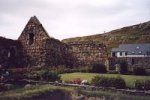 The monastery on Iona
The monastery on Iona
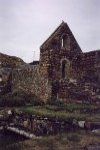 More of the monastery on Iona
More of the monastery on Iona
The abbey, however, was in fine shape. It reminded me of the National Cathedral near Washington, D.C. with its high vaulted ceilings and tall, pointed window frames which draw the eye toward heaven.
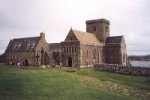 The abbey on Iona
The abbey on Iona
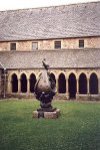 More of the abbey on Iona
More of the abbey on Iona
I wandered around, lost in antiquity for a time, then realized that I had managed to lose everyone else in my party as well. After spending some time looking for them, I headed back to where the ferry was to pick us up for the return trip to Mull. And I'd have gotten there a lot sooner had I not spotted a small used book store. (This was to be the first of many times I would slow us all down by being sucked into a book store.) As it turned out, I was soon congratulating myself for having stopped, since I turned up two books which considerable effort had failed to locate in the States: Catriona (the sequel to Robert Louis Stevenson's Kidnapped) and The Fair Maid of Perth (a novel by Sir Walter Scott that is said to be a fine snapshot of life in fourteenth-century Scotland). I forced myself to stop at two books, then scuttled off to rejoin my party who were addressing postcards while they waited patiently for me at the quay.
The ferry arrived, and back we went to retake our seats in Clem's coach. We passed the remains of an ancient "crannog," which was a fortified island built up in the middle of a loch from which the local clansmen would defend themselves. (This was something I'd read about and very much wanted to see.) And we saw the small islands off of Mull's western coast (such as Staffa, the inspiration for Mendelssohn's "Fingal's Cave"), which had been masked by showers on our way south that morning. But Clem really redeemed himself in my eyes by making one stop along the way of our return trip across Mull at a scenic overlook. Two circular lochs of cold indigo were nestled between a pair of long parallel green ridges, all warmed by the mellow afternoon sunlight.
After that moment of scenic grandeur, Duart Castle, long-time home to the MacLeans of Duart, seemed almost out of place atop a cliff on Mull's shoreline.
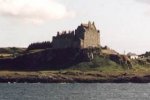 Duart Castle
Duart Castle
| AUGUST 1995 | ||||||
| Sunday | Monday | Tuesday | Wednesday | Thursday | Friday | Saturday |
| 18 | 19 | |||||
| 20 | 21 | 22 |
23 Oban |
24 | 25 | 26 |
| 27 | 28 | 29 | 30 | 31 | ||
| SEPTEMBER 1995 | ||||||
| Sunday | Monday | Tuesday | Wednesday | Thursday | Friday | Saturday |
| 1 | 2 | |||||
| 3 | ||||||
Home
Heart |
Body |
Spirit |
Mind |
| Art | Writing | Religion | Personality |
| Music | Travel | Politics | Computers |
| Genealogy | Work | History | Reasoning |
| Fiction | Games | Economics | Science |